|
|
|
STRADANUS Johannes
Chasse des Loutres
- s.n., s.l. s.d (circa 1590), 34,5 X 26 cm (cuvette: 29,5 X 21 cm). , une feuille. - Authentique gravure originale réalisée au burin d'après une peinture du XVIe siècle de Johannes Stradanus. Epreuve sur papier vergé filigrané, travail de la fin du XVIe ou du tout début du XVIIe siècle. Signature de l'artiste dans la planche. Légende en latin dans la partie inférieure de la gravure. Traduction manuscrite ancienne sous la cuvette : "Ainsi se chassent les loutres dans des barques en châne creux. Elles sont frappées dans l'eau avec un trident crochu". Filigrane visible par transparence. La gravure a été montée sur onglet et restaurée à l'aide de petits morceaux de papier vergé ancien encollé sur les bords au dos de celle-ci, sinon bel état de conservation pour cette gravure très rare. Johannes Stradanus, dit Giovanni Stradano ou Jan van der Straet est un peintre et graveur flamand, né à Bruges en 1523 et mort à Florence le 11 février 1605. Après avoir commencé à apprendre la peinture auprès de son père, et suite au décès de ce dernier, il poursuit sa formation dans l'atelier de Maximiliaan Frank (de 1535 à 1537), puis dans celui de Pieter Aertsen à Anvers (de 1537 à 1540). En 1545, il est reçu franc-maître à la guilde des peintres anversois. Il commence alors un voyage à travers l'Europe : en France, puis en Italie, où il séjourne d'abord à Venise, avant de s'installer à Florence. Il y travaille pour Cosme Ier de Médicis et collabore avec Giorgio Vasari pour la décoration du Studiolo de François Ier de Médicis, et pour celle de la salle de Clément VII du Palazzo Vecchio. En 1565, il fait partie des équipes de peintres et de sculpteurs chargés, sous la direction de Giorgio Vasari, de réaliser le gigantesque décor prévu pour l'entrée dans Florence de Jeanne d'Autriche, à l'occasion de son mariage avec François Ier de Médicis. Grandement influencé par les maniéristes, dont Michel-Ange, Johannes Stradanus contribue au développement de la grande peinture d'histoire à l'italienne. Il peint plusieurs retables pour des églises florentines. Il séjourne aussi à Rome de 1550 à 1553 et à Naples en 1576. Après un séjour à Anvers en 1578, il consacre une grande partie de son activité à la gravure. [ENGLISH DESCRIPTION ON DEMAND]

|
|
|
STRADANUS Johannes & COLLAERT Adrian
La chasse aux porcs-épics
- s.n., s.l. fin XVIe début XVIIe, 34 X 25,5 cm (cuvette: 27,5 X 20,5 cm). , une feuille. - Authentique gravure originale réalisée au burin d'après un dessin du XVIe siècle de Johannes Stradanus. Epreuve sur papier vergé filigrané, travail de la fin du XVIe ou du tout début du XVIIe siècle. Signatures des artistes dans la planche. Légende en latin dans la partie inférieure de la gravure. Traduction manuscrite d'une écriture ancienne sous la cuvette : "Dans l'hiver, le porc-épic est pris par des chiens ou dans des filets, ou lorsqu'il s'enfuit pour se cacher dans des trous obscurs, les chasseurs les poursuivent avec des rateaux et des hoyaux". Filigrane visible par transparence. Les marges de la gravure ont été doublées à l'aide de petits morceaux de papier vergé ancien encollés sur les bords au dos de celles-ci, sinon bel état de conservation pour cette gravure très rare. Johannes Stradanus, dit Giovanni Stradano ou Jan van der Straet est un peintre et graveur flamand, né à Bruges en 1523 et mort à Florence le 11 février 1605. Après avoir commencé à apprendre la peinture auprès de son père, et suite au décès de ce dernier, il poursuit sa formation dans l'atelier de Maximiliaan Frank (de 1535 à 1537), puis dans celui de Pieter Aertsen à Anvers (de 1537 à 1540). En 1545, il est reçu franc-maître à la guilde des peintres anversois. Il commence alors un voyage à travers l'Europe : en France, puis en Italie, où il séjourne d'abord à Venise, avant de s'installer à Florence. Il y travaille pour Cosme Ier de Médicis et collabore avec Giorgio Vasari pour la décoration du Studiolo de François Ier de Médicis, et pour celle de la salle de Clément VII du Palazzo Vecchio. En 1565, il fait partie des équipes de peintres et de sculpteurs chargés, sous la direction de Giorgio Vasari, de réaliser le gigantesque décor prévu pour l'entrée dans Florence de Jeanne d'Autriche, à l'occasion de son mariage avec François Ier de Médicis. Grandement influencé par les maniéristes, dont Michel-Ange, Johannes Stradanus contribue au développement de la grande peinture d'histoire à l'italienne. Il peint plusieurs retables pour des églises florentines. Il séjourne aussi à Rome de 1550 à 1553 et à Naples en 1576. Après un séjour à Anvers en 1578, il consacre une grande partie de son activité à la gravure. Adrian Collaert, né à Anvers en 1565 et mort en 1618, fit partie d'une grande famille de graveurs. Formé dans l'atelier de son beau-père Philippe Galle, il commenca par la gravure sur cuivre avant de se spécialiser dans le burin. [ENGLISH DESCRIPTION ON DEMAND]

|
|
|
STRADANUS Johannes & GALLE Philippe
Chasse aux canards
- s.n., s.l. s.d (circa 1590), 34 X 25,5 cm (cuvette: 27,5 X 20,5 cm). , une feuille. - Authentique gravure originale réalisée au burin d'après une peinture du XVIe siècle de Johannes Stradanus. Epreuve sur papier vergé filigrané, travail de la fin du XVIe ou du tout début du XVIIe siècle. Signatures des artistes dans la planche. Légende en latin dans la partie inférieure de la gravure. Traduction manuscrite d'une écriture ancienne sous la cuvette : "Ainsi les canards attachés sur le fleuve chantent, pendant que ceux qui surviennent sont blessés d'un coup de feu et charpillent leurs plumes sur le fleuve". Filigrane visible par transparence. La gravure a été montée sur onglet et restaurée à l'aide de petits morceaux de papier vergé ancien encollé sur les bords au dos de celle-ci, sinon bel état de conservation pour cette gravure très rare. Johannes Stradanus, dit Giovanni Stradano ou Jan van der Straet est un peintre et graveur flamand, né à Bruges en 1523 et mort à Florence le 11 février 1605. Après avoir commencé à apprendre la peinture auprès de son père, et suite au décès de ce dernier, il poursuit sa formation dans l'atelier de Maximiliaan Frank (de 1535 à 1537), puis dans celui de Pieter Aertsen à Anvers (de 1537 à 1540). En 1545, il est reçu franc-maître à la guilde des peintres anversois. Il commence alors un voyage à travers l'Europe : en France, puis en Italie, où il séjourne d'abord à Venise, avant de s'installer à Florence. Il y travaille pour Cosme Ier de Médicis et collabore avec Giorgio Vasari pour la décoration du Studiolo de François Ier de Médicis, et pour celle de la salle de Clément VII du Palazzo Vecchio. En 1565, il fait partie des équipes de peintres et de sculpteurs chargés, sous la direction de Giorgio Vasari, de réaliser le gigantesque décor prévu pour l'entrée dans Florence de Jeanne d'Autriche, à l'occasion de son mariage avec François Ier de Médicis. Grandement influencé par les maniéristes, dont Michel-Ange, Johannes Stradanus contribue au développement de la grande peinture d'histoire à l'italienne. Il peint plusieurs retables pour des églises florentines. Il séjourne aussi à Rome de 1550 à 1553 et à Naples en 1576. Après un séjour à Anvers en 1578, il consacre une grande partie de son activité à la gravure. Philippe Galle, né à Haarlem en 1537 et mort à Anvers en mars 1612, est un graveur flamand, membre d'une célèbre famille de graveurs. Il a pratiqué la gravure sur cuivre, le dessin, le commerce de gavures, l'édition et l'écriture. Il se forme auprès de Jérôme Cock, à Anvers, où il grave des dessins de Pieter Bruegel l'Ancien, notamment la série des Sept péchés capitaux. Il devient ensuite le graveur de Maarten van Heemskerck. À partir de 1557, il possède son propre atelier, qui sera fréquenté par ses fils, Théodore et Cornelius, ainsi que par son beau-fils, Adriaen Collaert, les frères Wierix, Hendrick Goltzius, Crispin de Passe l'Ancien et d'autres membres de la famille Collaert. Son atelier est au centre de la production de gravures anversoise. Philippe Galle a réalisé quelques-unes de ses uvres les plus admirables sur des projets de Pieter Bruegel l'Ancien (L'Alchimiste, 1558), de Jan van der Straet, de Franz Floris (Les Filles de Loth) et de Gillis Congnet (Aenevm Saecvlvm et les quatre ages de l'humanité, 1575). [ENGLISH DESCRIPTION ON DEMAND]

|
|
|
STRADANUS Johannes & GALLE Philippe
L'entrainement des chiens à la chasse aux cerfs
- s.n., s.l. fin XVIe début XVIIe, 34 X 25,5 cm (cuvette: 27,5 X 20,5 cm). , une feuille. - Authentique gravure originale réalisée au burin d'après un dessin du XVIe siècle de Johannes Stradanus. Epreuve sur papier vergé filigrané, travail de la fin du XVIe ou du tout début du XVIIe siècle. Signatures des artistes dans la planche. Légende en latin dans la partie inférieure de la gravure. Traduction manuscrite d'une écriture ancienne sous la cuvette : "Des chasseurs par le commandement du roi de France cherchent beaucoup de fientes de cerfs et donnent les crottes des jeunes cerfs aux chiens afin que par l'odeur ils apprennent à connaitre l'âge des cerfs..". Filigrane visible par transparence. Les marges de la gravure ont été doublées à l'aide de petits morceaux de papier vergé ancien encollés sur les bords au dos de celles-ci, sinon bel état de conservation pour cette gravure très rare. Johannes Stradanus, dit Giovanni Stradano ou Jan van der Straet est un peintre et graveur flamand, né à Bruges en 1523 et mort à Florence le 11 février 1605. Après avoir commencé à apprendre la peinture auprès de son père, et suite au décès de ce dernier, il poursuit sa formation dans l'atelier de Maximiliaan Frank (de 1535 à 1537), puis dans celui de Pieter Aertsen à Anvers (de 1537 à 1540). En 1545, il est reçu franc-maître à la guilde des peintres anversois. Il commence alors un voyage à travers l'Europe : en France, puis en Italie, où il séjourne d'abord à Venise, avant de s'installer à Florence. Il y travaille pour Cosme Ier de Médicis et collabore avec Giorgio Vasari pour la décoration du Studiolo de François Ier de Médicis, et pour celle de la salle de Clément VII du Palazzo Vecchio. En 1565, il fait partie des équipes de peintres et de sculpteurs chargés, sous la direction de Giorgio Vasari, de réaliser le gigantesque décor prévu pour l'entrée dans Florence de Jeanne d'Autriche, à l'occasion de son mariage avec François Ier de Médicis. Grandement influencé par les maniéristes, dont Michel-Ange, Johannes Stradanus contribue au développement de la grande peinture d'histoire à l'italienne. Il peint plusieurs retables pour des églises florentines. Il séjourne aussi à Rome de 1550 à 1553 et à Naples en 1576. Après un séjour à Anvers en 1578, il consacre une grande partie de son activité à la gravure. Philippe Galle, né à Haarlem en 1537 et mort à Anvers en mars 1612, est un graveur flamand, membre d'une célèbre famille de graveurs. Il a pratiqué la gravure sur cuivre, le dessin, le commerce de gavures, l'édition et l'écriture. Il se forme auprès de Jérôme Cock, à Anvers, où il grave des dessins de Pieter Bruegel l'Ancien, notamment la série des Sept péchés capitaux. Il devient ensuite le graveur de Maarten van Heemskerck. À partir de 1557, il possède son propre atelier, qui sera fréquenté par ses fils, Théodore et Cornelius, ainsi que par son beau-fils, Adriaen Collaert, les frères Wierix, Hendrick Goltzius, Crispin de Passe l'Ancien et d'autres membres de la famille Collaert. Son atelier est au centre de la production de gravures anversoise. Philippe Galle a réalisé quelques-unes de ses uvres les plus admirables sur des projets de Pieter Bruegel l'Ancien (L'Alchimiste, 1558), de Jan van der Straet, de Franz Floris (Les Filles de Loth) et de Gillis Congnet (Aenevm Saecvlvm et les quatre ages de l'humanité, 1575). [ENGLISH DESCRIPTION ON DEMAND]

|
|
|
STRADANUS Johannes & GALLE Philippe
La chasse aux lions par le feu
- s.n., s.l. fin XVIe début XVIIe, 34 X 25,5 cm (cuvette: 27,5 X 20,5 cm). , une feuille. - Authentique gravure originale réalisée au burin d'après un dessin du XVIe siècle de Johannes Stradanus. Epreuve sur papier vergé filigrané, travail de la fin du XVIe ou du tout début du XVIIe siècle. Signatures des artistes dans la planche. Légende en latin dans la partie inférieure de la gravure. Traduction manuscrite d'une écriture ancienne sous la cuvette : "Ceux qui s'occupent à surprendre les lions dans des filets portent une torche de la main gauche et un bouclier de la droite pour se garantir du feu: les lions fuyant les flammes, se jettent dans les filets qu'on lui a tendu.". Filigrane visible par transparence. Les marges de la gravure ont été doublées à l'aide de petits morceaux de papier vergé ancien encollés sur les bords au dos de celles-ci, sinon bel état de conservation pour cette gravure très rare. Johannes Stradanus, dit Giovanni Stradano ou Jan van der Straet est un peintre et graveur flamand, né à Bruges en 1523 et mort à Florence le 11 février 1605. Après avoir commencé à apprendre la peinture auprès de son père, et suite au décès de ce dernier, il poursuit sa formation dans l'atelier de Maximiliaan Frank (de 1535 à 1537), puis dans celui de Pieter Aertsen à Anvers (de 1537 à 1540). En 1545, il est reçu franc-maître à la guilde des peintres anversois. Il commence alors un voyage à travers l'Europe : en France, puis en Italie, où il séjourne d'abord à Venise, avant de s'installer à Florence. Il y travaille pour Cosme Ier de Médicis et collabore avec Giorgio Vasari pour la décoration du Studiolo de François Ier de Médicis, et pour celle de la salle de Clément VII du Palazzo Vecchio. En 1565, il fait partie des équipes de peintres et de sculpteurs chargés, sous la direction de Giorgio Vasari, de réaliser le gigantesque décor prévu pour l'entrée dans Florence de Jeanne d'Autriche, à l'occasion de son mariage avec François Ier de Médicis. Grandement influencé par les maniéristes, dont Michel-Ange, Johannes Stradanus contribue au développement de la grande peinture d'histoire à l'italienne. Il peint plusieurs retables pour des églises florentines. Il séjourne aussi à Rome de 1550 à 1553 et à Naples en 1576. Après un séjour à Anvers en 1578, il consacre une grande partie de son activité à la gravure. Philippe Galle, né à Haarlem en 1537 et mort à Anvers en mars 1612, est un graveur flamand, membre d'une célèbre famille de graveurs. Il a pratiqué la gravure sur cuivre, le dessin, le commerce de gavures, l'édition et l'écriture. Il se forme auprès de Jérôme Cock, à Anvers, où il grave des dessins de Pieter Bruegel l'Ancien, notamment la série des Sept péchés capitaux. Il devient ensuite le graveur de Maarten van Heemskerck. À partir de 1557, il possède son propre atelier, qui sera fréquenté par ses fils, Théodore et Cornelius, ainsi que par son beau-fils, Adriaen Collaert, les frères Wierix, Hendrick Goltzius, Crispin de Passe l'Ancien et d'autres membres de la famille Collaert. Son atelier est au centre de la production de gravures anversoise. Philippe Galle a réalisé quelques-unes de ses uvres les plus admirables sur des projets de Pieter Bruegel l'Ancien (L'Alchimiste, 1558), de Jan van der Straet, de Franz Floris (Les Filles de Loth) et de Gillis Congnet (Aenevm Saecvlvm et les quatre ages de l'humanité, 1575). [ENGLISH DESCRIPTION ON DEMAND]

|
|
|
STRADANUS Johannes & GALLE Philippe
Le combat des oiseaux et des couleuvres
- s.n., s.l. fin XVIe début XVIIe, 34 X 25,5 cm (cuvette: 27,5 X 20,5 cm). , une feuille. - Authentique gravure originale réalisée au burin d'après un dessin du XVIe siècle de Johannes Stradanus. Epreuve sur papier vergé filigrané, travail de la fin du XVIe ou du tout début du XVIIe siècle. Signatures des artistes dans la planche. Légende en latin dans la partie inférieure de la gravure. Traduction manuscrite d'une écriture ancienne sous la cuvette : "Le désert d'Appulie nourrit de couleuvres les grues et aussi les cigognes attaquent leurs nichées. Elles engagent le combat avec vigueur de leurs becs et les mordent. Le spectacle est très divertissant pour les colons". Filigrane visible par transparence. Les marges de la gravure ont été doublées à l'aide de petits morceaux de papier vergé ancien encollés sur les bords au dos de celles-ci, sinon bel état de conservation pour cette gravure très rare. Johannes Stradanus, dit Giovanni Stradano ou Jan van der Straet est un peintre et graveur flamand, né à Bruges en 1523 et mort à Florence le 11 février 1605. Après avoir commencé à apprendre la peinture auprès de son père, et suite au décès de ce dernier, il poursuit sa formation dans l'atelier de Maximiliaan Frank (de 1535 à 1537), puis dans celui de Pieter Aertsen à Anvers (de 1537 à 1540). En 1545, il est reçu franc-maître à la guilde des peintres anversois. Il commence alors un voyage à travers l'Europe : en France, puis en Italie, où il séjourne d'abord à Venise, avant de s'installer à Florence. Il y travaille pour Cosme Ier de Médicis et collabore avec Giorgio Vasari pour la décoration du Studiolo de François Ier de Médicis, et pour celle de la salle de Clément VII du Palazzo Vecchio. En 1565, il fait partie des équipes de peintres et de sculpteurs chargés, sous la direction de Giorgio Vasari, de réaliser le gigantesque décor prévu pour l'entrée dans Florence de Jeanne d'Autriche, à l'occasion de son mariage avec François Ier de Médicis. Grandement influencé par les maniéristes, dont Michel-Ange, Johannes Stradanus contribue au développement de la grande peinture d'histoire à l'italienne. Il peint plusieurs retables pour des églises florentines. Il séjourne aussi à Rome de 1550 à 1553 et à Naples en 1576. Après un séjour à Anvers en 1578, il consacre une grande partie de son activité à la gravure. Philippe Galle, né à Haarlem en 1537 et mort à Anvers en mars 1612, est un graveur flamand, membre d'une célèbre famille de graveurs. Il a pratiqué la gravure sur cuivre, le dessin, le commerce de gavures, l'édition et l'écriture. Il se forme auprès de Jérôme Cock, à Anvers, où il grave des dessins de Pieter Bruegel l'Ancien, notamment la série des Sept péchés capitaux. Il devient ensuite le graveur de Maarten van Heemskerck. À partir de 1557, il possède son propre atelier, qui sera fréquenté par ses fils, Théodore et Cornelius, ainsi que par son beau-fils, Adriaen Collaert, les frères Wierix, Hendrick Goltzius, Crispin de Passe l'Ancien et d'autres membres de la famille Collaert. Son atelier est au centre de la production de gravures anversoise. Philippe Galle a réalisé quelques-unes de ses uvres les plus admirables sur des projets de Pieter Bruegel l'Ancien (L'Alchimiste, 1558), de Jan van der Straet, de Franz Floris (Les Filles de Loth) et de Gillis Congnet (Aenevm Saecvlvm et les quatre ages de l'humanité, 1575). [ENGLISH DESCRIPTION ON DEMAND]

|
|
|
STRADANUS Johannes & GALLE Philippe & COLLAERT Adrian
La capture du tigre
- s.n., s.l. fin XVIe début XVIIe, 34 X 25,5 cm (cuvette: 27,5 X 20,5 cm). , une feuille. - Authentique gravure originale réalisée au burin d'après un dessin du XVIe siècle de Johannes Stradanus. Epreuve sur papier vergé filigrané, travail de la fin du XVIe ou du tout début du XVIIe siècle. Signatures des artistes dans la planche. Légende en latin dans la partie inférieure de la gravure. Traduction manuscrite d'une écriture ancienne sous la cuvette : "Le chasseur prend les petits du tigre et met dans des trappes des miroirs qui représentent les petits qu'il a enlevés. Cette bête stupide croyant les voir effectivement, entre dans les filets et hurle, étant prise.". Filigrane visible par transparence. Les marges de la gravure ont été doublées à l'aide de petits morceaux de papier vergé ancien encollés sur les bords au dos de celles-ci, sinon bel état de conservation pour cette gravure très rare. Johannes Stradanus, dit Giovanni Stradano ou Jan van der Straet est un peintre et graveur flamand, né à Bruges en 1523 et mort à Florence le 11 février 1605. Après avoir commencé à apprendre la peinture auprès de son père, et suite au décès de ce dernier, il poursuit sa formation dans l'atelier de Maximiliaan Frank (de 1535 à 1537), puis dans celui de Pieter Aertsen à Anvers (de 1537 à 1540). En 1545, il est reçu franc-maître à la guilde des peintres anversois. Il commence alors un voyage à travers l'Europe : en France, puis en Italie, où il séjourne d'abord à Venise, avant de s'installer à Florence. Il y travaille pour Cosme Ier de Médicis et collabore avec Giorgio Vasari pour la décoration du Studiolo de François Ier de Médicis, et pour celle de la salle de Clément VII du Palazzo Vecchio. En 1565, il fait partie des équipes de peintres et de sculpteurs chargés, sous la direction de Giorgio Vasari, de réaliser le gigantesque décor prévu pour l'entrée dans Florence de Jeanne d'Autriche, à l'occasion de son mariage avec François Ier de Médicis. Grandement influencé par les maniéristes, dont Michel-Ange, Johannes Stradanus contribue au développement de la grande peinture d'histoire à l'italienne. Il peint plusieurs retables pour des églises florentines. Il séjourne aussi à Rome de 1550 à 1553 et à Naples en 1576. Après un séjour à Anvers en 1578, il consacre une grande partie de son activité à la gravure. Philippe Galle, né à Haarlem en 1537 et mort à Anvers en mars 1612, est un graveur flamand, membre d'une célèbre famille de graveurs. Il a pratiqué la gravure sur cuivre, le dessin, le commerce de gavures, l'édition et l'écriture. Il se forme auprès de Jérôme Cock, à Anvers, où il grave des dessins de Pieter Bruegel l'Ancien, notamment la série des Sept péchés capitaux. Il devient ensuite le graveur de Maarten van Heemskerck. À partir de 1557, il possède son propre atelier, qui sera fréquenté par ses fils, Théodore et Cornelius, ainsi que par son beau-fils, Adriaen Collaert, les frères Wierix, Hendrick Goltzius, Crispin de Passe l'Ancien et d'autres membres de la famille Collaert. Son atelier est au centre de la production de gravures anversoise. Philippe Galle a réalisé quelques-unes de ses uvres les plus admirables sur des projets de Pieter Bruegel l'Ancien (L'Alchimiste, 1558), de Jan van der Straet, de Franz Floris (Les Filles de Loth) et de Gillis Congnet (Aenevm Saecvlvm et les quatre ages de l'humanité, 1575). Adrian Collaert, né à Anvers en 1565 et mort en 1618, fit partie d'une grande famille de graveurs. Formé dans l'atelier de son beau-père Philippe Galle, il commenca par la gravure sur cuivre avant de se spécialiser dans le burin. [ENGLISH DESCRIPTION ON DEMAND]

|
|
|
STRADANUS Johannes & GALLE Philippe & COLLAERT Adrian
La chasse au bubale
- s.n., s.l. fin XVIe début XVIIe, 34 X 25,5 cm (cuvette: 27,5 X 20,5 cm). , une feuille. - Authentique gravure originale réalisée au burin d'après un dessin du XVIe siècle de Johannes Stradanus. Epreuve sur papier vergé filigrané, travail de la fin du XVIe ou du tout début du XVIIe siècle. Signatures des artistes dans la planche. Légende en latin dans la partie inférieure de la gravure. Traduction manuscrite d'une écriture ancienne sous la cuvette : "Le bubale est une espèce de boeuf cruel et féroce. Les chasseurs pour le prendre le lassent en faisant courir et aboyer des chiens après lui, qui le mordent, jusqu'à ce qu'il tombe, n'en pouvant plus". Filigrane visible par transparence. Les marges de la gravure ont été doublées à l'aide de petits morceaux de papier vergé ancien encollés sur les bords au dos de celles-ci, sinon bel état de conservation pour cette gravure très rare. Johannes Stradanus, dit Giovanni Stradano ou Jan van der Straet est un peintre et graveur flamand, né à Bruges en 1523 et mort à Florence le 11 février 1605. Après avoir commencé à apprendre la peinture auprès de son père, et suite au décès de ce dernier, il poursuit sa formation dans l'atelier de Maximiliaan Frank (de 1535 à 1537), puis dans celui de Pieter Aertsen à Anvers (de 1537 à 1540). En 1545, il est reçu franc-maître à la guilde des peintres anversois. Il commence alors un voyage à travers l'Europe : en France, puis en Italie, où il séjourne d'abord à Venise, avant de s'installer à Florence. Il y travaille pour Cosme Ier de Médicis et collabore avec Giorgio Vasari pour la décoration du Studiolo de François Ier de Médicis, et pour celle de la salle de Clément VII du Palazzo Vecchio. En 1565, il fait partie des équipes de peintres et de sculpteurs chargés, sous la direction de Giorgio Vasari, de réaliser le gigantesque décor prévu pour l'entrée dans Florence de Jeanne d'Autriche, à l'occasion de son mariage avec François Ier de Médicis. Grandement influencé par les maniéristes, dont Michel-Ange, Johannes Stradanus contribue au développement de la grande peinture d'histoire à l'italienne. Il peint plusieurs retables pour des églises florentines. Il séjourne aussi à Rome de 1550 à 1553 et à Naples en 1576. Après un séjour à Anvers en 1578, il consacre une grande partie de son activité à la gravure. Philippe Galle, né à Haarlem en 1537 et mort à Anvers en mars 1612, est un graveur flamand, membre d'une célèbre famille de graveurs. Il a pratiqué la gravure sur cuivre, le dessin, le commerce de gavures, l'édition et l'écriture. Il se forme auprès de Jérôme Cock, à Anvers, où il grave des dessins de Pieter Bruegel l'Ancien, notamment la série des Sept péchés capitaux. Il devient ensuite le graveur de Maarten van Heemskerck. À partir de 1557, il possède son propre atelier, qui sera fréquenté par ses fils, Théodore et Cornelius, ainsi que par son beau-fils, Adriaen Collaert, les frères Wierix, Hendrick Goltzius, Crispin de Passe l'Ancien et d'autres membres de la famille Collaert. Son atelier est au centre de la production de gravures anversoise. Philippe Galle a réalisé quelques-unes de ses uvres les plus admirables sur des projets de Pieter Bruegel l'Ancien (L'Alchimiste, 1558), de Jan van der Straet, de Franz Floris (Les Filles de Loth) et de Gillis Congnet (Aenevm Saecvlvm et les quatre ages de l'humanité, 1575). Adrian Collaert, né à Anvers en 1565 et mort en 1618, fit partie d'une grande famille de graveurs. Formé dans l'atelier de son beau-père Philippe Galle, il commenca par la gravure sur cuivre avant de se spécialiser dans le burin. [ENGLISH DESCRIPTION ON DEMAND]

|
|
|
STRADANUS Johannes & GALLE Philippe & COLLAERT Adrian
La chasse aux chameaux
- s.n., s.l. fin XVIe début XVIIe, 34 X 25,5 cm (cuvette: 27,5 X 20,5 cm). , une feuille. - Authentique gravure originale réalisée au burin d'après un dessin du XVIe siècle de Johannes Stradanus. Epreuve sur papier vergé filigrané, travail de la fin du XVIe ou du tout début du XVIIe siècle. Signatures des artistes dans la planche. Légende en latin dans la partie inférieure de la gravure. Traduction manuscrite d'une écriture ancienne sous la cuvette : "On dit que la Barbarie produit de très bons chameaux que chassent les soldats de la marine pressés par la faim. Cette viande quoique très dure les rassasie.". Filigrane visible par transparence. Les marges de la gravure ont été doublées à l'aide de petits morceaux de papier vergé ancien encollés sur les bords au dos de celles-ci, sinon bel état de conservation pour cette gravure très rare. Johannes Stradanus, dit Giovanni Stradano ou Jan van der Straet est un peintre et graveur flamand, né à Bruges en 1523 et mort à Florence le 11 février 1605. Après avoir commencé à apprendre la peinture auprès de son père, et suite au décès de ce dernier, il poursuit sa formation dans l'atelier de Maximiliaan Frank (de 1535 à 1537), puis dans celui de Pieter Aertsen à Anvers (de 1537 à 1540). En 1545, il est reçu franc-maître à la guilde des peintres anversois. Il commence alors un voyage à travers l'Europe : en France, puis en Italie, où il séjourne d'abord à Venise, avant de s'installer à Florence. Il y travaille pour Cosme Ier de Médicis et collabore avec Giorgio Vasari pour la décoration du Studiolo de François Ier de Médicis, et pour celle de la salle de Clément VII du Palazzo Vecchio. En 1565, il fait partie des équipes de peintres et de sculpteurs chargés, sous la direction de Giorgio Vasari, de réaliser le gigantesque décor prévu pour l'entrée dans Florence de Jeanne d'Autriche, à l'occasion de son mariage avec François Ier de Médicis. Grandement influencé par les maniéristes, dont Michel-Ange, Johannes Stradanus contribue au développement de la grande peinture d'histoire à l'italienne. Il peint plusieurs retables pour des églises florentines. Il séjourne aussi à Rome de 1550 à 1553 et à Naples en 1576. Après un séjour à Anvers en 1578, il consacre une grande partie de son activité à la gravure. Philippe Galle, né à Haarlem en 1537 et mort à Anvers en mars 1612, est un graveur flamand, membre d'une célèbre famille de graveurs. Il a pratiqué la gravure sur cuivre, le dessin, le commerce de gavures, l'édition et l'écriture. Il se forme auprès de Jérôme Cock, à Anvers, où il grave des dessins de Pieter Bruegel l'Ancien, notamment la série des Sept péchés capitaux. Il devient ensuite le graveur de Maarten van Heemskerck. À partir de 1557, il possède son propre atelier, qui sera fréquenté par ses fils, Théodore et Cornelius, ainsi que par son beau-fils, Adriaen Collaert, les frères Wierix, Hendrick Goltzius, Crispin de Passe l'Ancien et d'autres membres de la famille Collaert. Son atelier est au centre de la production de gravures anversoise. Philippe Galle a réalisé quelques-unes de ses uvres les plus admirables sur des projets de Pieter Bruegel l'Ancien (L'Alchimiste, 1558), de Jan van der Straet, de Franz Floris (Les Filles de Loth) et de Gillis Congnet (Aenevm Saecvlvm et les quatre ages de l'humanité, 1575). Adrian Collaert, né à Anvers en 1565 et mort en 1618, fit partie d'une grande famille de graveurs. Formé dans l'atelier de son beau-père Philippe Galle, il commenca par la gravure sur cuivre avant de se spécialiser dans le burin. [ENGLISH DESCRIPTION ON DEMAND]

|
|
|
STRADANUS Johannes & GALLE Philippe & COLLAERT Adrian
La mésaventure du chasseur
- s.n., s.l. fin XVIe début XVIIe, 34 X 25,5 cm (cuvette: 27,5 X 20,5 cm). , une feuille. - Authentique gravure originale réalisée au burin d'après un dessin du XVIe siècle de Johannes Stradanus. Epreuve sur papier vergé filigrané, travail de la fin du XVIe ou du tout début du XVIIe siècle. Signatures des artistes dans la planche. Légende en latin dans la partie inférieure de la gravure. Traduction manuscrite d'une écriture ancienne sous la cuvette : "Souvent un chasseur tombe sans prendre garde dans des cavernes ou des grottes couvertes d'herbes par dessus d'où ses compagnons ne peuvent le retirer, mais il meurt malheureusement et demeure la pature des serpents qui y sont et des hydres ". Filigrane visible par transparence. Les marges de la gravure ont été doublées à l'aide de petits morceaux de papier vergé ancien encollés sur les bords au dos de celles-ci, sinon bel état de conservation pour cette gravure très rare. Johannes Stradanus, dit Giovanni Stradano ou Jan van der Straet est un peintre et graveur flamand, né à Bruges en 1523 et mort à Florence le 11 février 1605. Après avoir commencé à apprendre la peinture auprès de son père, et suite au décès de ce dernier, il poursuit sa formation dans l'atelier de Maximiliaan Frank (de 1535 à 1537), puis dans celui de Pieter Aertsen à Anvers (de 1537 à 1540). En 1545, il est reçu franc-maître à la guilde des peintres anversois. Il commence alors un voyage à travers l'Europe : en France, puis en Italie, où il séjourne d'abord à Venise, avant de s'installer à Florence. Il y travaille pour Cosme Ier de Médicis et collabore avec Giorgio Vasari pour la décoration du Studiolo de François Ier de Médicis, et pour celle de la salle de Clément VII du Palazzo Vecchio. En 1565, il fait partie des équipes de peintres et de sculpteurs chargés, sous la direction de Giorgio Vasari, de réaliser le gigantesque décor prévu pour l'entrée dans Florence de Jeanne d'Autriche, à l'occasion de son mariage avec François Ier de Médicis. Grandement influencé par les maniéristes, dont Michel-Ange, Johannes Stradanus contribue au développement de la grande peinture d'histoire à l'italienne. Il peint plusieurs retables pour des églises florentines. Il séjourne aussi à Rome de 1550 à 1553 et à Naples en 1576. Après un séjour à Anvers en 1578, il consacre une grande partie de son activité à la gravure. Philippe Galle, né à Haarlem en 1537 et mort à Anvers en mars 1612, est un graveur flamand, membre d'une célèbre famille de graveurs. Il a pratiqué la gravure sur cuivre, le dessin, le commerce de gavures, l'édition et l'écriture. Il se forme auprès de Jérôme Cock, à Anvers, où il grave des dessins de Pieter Bruegel l'Ancien, notamment la série des Sept péchés capitaux. Il devient ensuite le graveur de Maarten van Heemskerck. À partir de 1557, il possède son propre atelier, qui sera fréquenté par ses fils, Théodore et Cornelius, ainsi que par son beau-fils, Adriaen Collaert, les frères Wierix, Hendrick Goltzius, Crispin de Passe l'Ancien et d'autres membres de la famille Collaert. Son atelier est au centre de la production de gravures anversoise. Philippe Galle a réalisé quelques-unes de ses uvres les plus admirables sur des projets de Pieter Bruegel l'Ancien (L'Alchimiste, 1558), de Jan van der Straet, de Franz Floris (Les Filles de Loth) et de Gillis Congnet (Aenevm Saecvlvm et les quatre ages de l'humanité, 1575). Adrian Collaert, né à Anvers en 1565 et mort en 1618, fit partie d'une grande famille de graveurs. Formé dans l'atelier de son beau-père Philippe Galle, il commenca par la gravure sur cuivre avant de se spécialiser dans le burin. [ENGLISH DESCRIPTION ON DEMAND]

|
|
|
STRADANUS Johannes & GALLE Philippe et Cornelius
La chasse aux vipères
- s.n., s.l. fin XVIe début XVIIe, 34 X 25,5 cm (cuvette: 27,5 X 20,5 cm). , une feuille. - Authentique gravure originale réalisée au burin d'après un dessin du XVIe siècle de Johannes Stradanus. Epreuve sur papier vergé filigrané, travail de la fin du XVIe ou du tout début du XVIIe siècle. Signatures des artistes dans la planche. Légende en latin dans la partie inférieure de la gravure. Traduction manuscrite d'une écriture ancienne sous la cuvette : "En Italie les vipères se plaisent à se cacher dans les marais. Quand elles entendent un chien aboyer, elles sortent des buissons. On les saisit alors avec une fourche et on les met dans un sac avec une pince. Elles sont préparées comme remède pharmaceutique". Filigrane visible par transparence. Les marges de la gravure ont été doublées à l'aide de petits morceaux de papier vergé ancien encollés sur les bords au dos de celles-ci, sinon bel état de conservation pour cette gravure très rare. Johannes Stradanus, dit Giovanni Stradano ou Jan van der Straet est un peintre et graveur flamand, né à Bruges en 1523 et mort à Florence le 11 février 1605. Après avoir commencé à apprendre la peinture auprès de son père, et suite au décès de ce dernier, il poursuit sa formation dans l'atelier de Maximiliaan Frank (de 1535 à 1537), puis dans celui de Pieter Aertsen à Anvers (de 1537 à 1540). En 1545, il est reçu franc-maître à la guilde des peintres anversois. Il commence alors un voyage à travers l'Europe : en France, puis en Italie, où il séjourne d'abord à Venise, avant de s'installer à Florence. Il y travaille pour Cosme Ier de Médicis et collabore avec Giorgio Vasari pour la décoration du Studiolo de François Ier de Médicis, et pour celle de la salle de Clément VII du Palazzo Vecchio. En 1565, il fait partie des équipes de peintres et de sculpteurs chargés, sous la direction de Giorgio Vasari, de réaliser le gigantesque décor prévu pour l'entrée dans Florence de Jeanne d'Autriche, à l'occasion de son mariage avec François Ier de Médicis. Grandement influencé par les maniéristes, dont Michel-Ange, Johannes Stradanus contribue au développement de la grande peinture d'histoire à l'italienne. Il peint plusieurs retables pour des églises florentines. Il séjourne aussi à Rome de 1550 à 1553 et à Naples en 1576. Après un séjour à Anvers en 1578, il consacre une grande partie de son activité à la gravure. Philippe Galle, né à Haarlem en 1537 et mort à Anvers en mars 1612, est un graveur flamand, membre d'une célèbre famille de graveurs. Il a pratiqué la gravure sur cuivre, le dessin, le commerce de gavures, l'édition et l'écriture. Il se forme auprès de Jérôme Cock, à Anvers, où il grave des dessins de Pieter Bruegel l'Ancien, notamment la série des Sept péchés capitaux. Il devient ensuite le graveur de Maarten van Heemskerck. À partir de 1557, il possède son propre atelier, qui sera fréquenté par ses fils, Théodore et Cornelius, ainsi que par son beau-fils, Adriaen Collaert, les frères Wierix, Hendrick Goltzius, Crispin de Passe l'Ancien et d'autres membres de la famille Collaert. Son atelier est au centre de la production de gravures anversoise. Philippe Galle a réalisé quelques-unes de ses uvres les plus admirables sur des projets de Pieter Bruegel l'Ancien (L'Alchimiste, 1558), de Jan van der Straet, de Franz Floris (Les Filles de Loth) et de Gillis Congnet (Aenevm Saecvlvm et les quatre ages de l'humanité, 1575). [ENGLISH DESCRIPTION ON DEMAND]

|
|
|
STRADANUS Johannes & VISSCHER Claes Jansz(attribué à)
Contremuit subito detentis carcere tellus Et Paulo et Sila, subitoque fragore refracti Carceris attonitus custos parat ense corusco Accelerare sibi fatum, sed fonte Iduatur. (Acto. 16.27.) Gravure originale du XVIIe siècle
- s.n., s.l. (Hollande) (Circa 1600), 33x27,5cm (cuvettes: 26x20,5cm), une feuille. - Gravure originale réalisée au burin par Claes Jansz Visscher, dit le Piscator d'après une peinture du XVI° siècle de Johannes Stradanus. Epreuve sur papier vergé filigrané, travail du début du XVIIe siècle. Il s'agit d'une illustration d'un passage des Actes des apôtres, 16.25-28: "Vers le milieu de la nuit, Paul et Silas priaient et chantaient les louanges de Dieu, et les prisonniers les entendaient. Tout à coup il se fit un grand tremblement de terre, en sorte que les fondements de la prison furent ébranlés; au même instant, toutes les portes s'ouvrirent, et les liens de tous les prisonniers furent rompus. Le geôlier se réveilla, et, lorsqu'il vit les portes de la prison ouvertes, il tira son épée et allait se tuer, pensant que les prisonniers s'étaient enfuis. Mais Paul cria d'une voix forte: Ne te fais point de mal, nous sommes tous ici.". Légende en latin dans la partie inférieure de la gravure. Signatures des artistes dans la planche. Mention numérotée "28" dans l'angle inférieur droit, dans la gravure. Mention manuscrite "161" en marge dans l'angle supérieur droit de la planche. Une annotation manuscrite ancienne en caractères grecs sous la cuvette. Filigrane d'une couronne visible par transparence. Infimes rousseurs et petites taches marginales, sans atteinte à la gravure, une habile restauration à l'aide d'une petite bande de filmoplast transparent au dos, sinon très bel état de conservation pour cette gravure extrêmement rare et d'une grande fraîcheur. Johannes Stradanus, dit Giovanni Stradano ou Jan van der Straet est un peintre et graveur flamand, né à Bruges en 1523 et mort à Florence le 11 février 1605. Après avoir commencé à apprendre la peinture auprès de son père, et suite au décès de ce dernier, il poursuit sa formation dans l'atelier de Maximiliaan Frank (de 1535 à 1537), puis dans celui de Pieter Aertsen à Anvers (de 1537 à 1540). En 1545, il est reçu franc-maître à la guilde des peintres anversois. Il commence un voyage à travers l'Europe : en France, puis en Italie, où il séjourne d'abord à Venise, avant de s'installer à Florence. Il y travaille pour Cosme Ier de Médicis et collabore avec Giorgio Vasari pour la décoration du Studiolo de François Ier de Médicis, et celle de la salle de Clément VII du Palazzo Vecchio. En 1565, il fait partie des équipes de peintres et de sculpteurs chargés, sous la direction de Giorgio Vasari, de réaliser le gigantesque décor prévu pour l'entrée dans Florence de Jeanne d'Autriche[1], à l'occasion de son mariage avec François Ier de Médicis. Grandement influencé par les maniéristes, dont Michel-Ange, Johannes Stradanus contribue au développement de la grande peinture d'histoire à l'italienne. Il peint plusieurs retables pour des églises florentines. Il séjourne aussi à Rome de 1550 à 1553 et à Naples en 1576.Après un séjour à Anvers en 1578, il consacre une grande partie de son activité à la gravure. [ENGLISH DESCRIPTION ON DEMAND]

|
|
|
STRADANUS Johannes & VISSCHER Claes Jansz(attribué à)
In Macedum terris, ad maenia nota Philippi, Cum docet aeterni Paulus miisteria Christi. Sub stimulo Pythonis, ait, bachata puella, Doctorem verique Dei Paulum esse ministrum. (Acto. 16.14.) Gravure originale du XVIIe siècle
- s.n., s.l. (Hollande) (Circa 1600), 33x27,5cm (cuvettes: 26,5x21cm), une feuille. - Gravure originale réalisée au burin par Claes Jansz Visscher, dit le Piscator d'après une peinture du XVI° siècle de Johannes Stradanus. Epreuve sur papier vergé filigrané, travail du début du XVIIe siècle.Il s'agit d'une illustration d'un passage des Actes des apôtres, 16.12-14: "De là nous allâmes à Philippes, qui est la première ville d'un district de Macédoine, et une colonie. Nous passâmes quelques jours dans cette ville. Le jour du sabbat, nous nous rendîmes, hors de la porte, vers une rivière, où nous pensions que se trouvait un lieu de prière. Nous nous assîmes, et nous parlâmes aux femmes qui étaient réunies. L'une d'elles, nommée Lydie, marchande de pourpre, de la ville de Thyatire, était une femme craignant Dieu, et elle écoutait. Le Seigneur lui ouvrit le coeur, pour qu'elle fût attentive à ce que disait Paul.".Légende en latin dans la partie inférieure de la gravure.Signatures des artistes dans la planche.Mention numérotée "27" dans l'angle inférieur droit, dans la gravure.Mention manuscrite "160" en marge dans l'angle supérieur droit de la planche.Une annotation manuscrite ancienne en caractères grecs sous la cuvette.Filigrane d'une couronne visible par transparence.Très rares et discrètes rousseurs marginales, une habile restauration à l'aide d'un petit morceau de filmoplast transparent au dos, sinon bel état de conservation pour cette gravure extrêmement rare et d'une grande fraîcheur.Johannes Stradanus, dit Giovanni Stradano ou Jan van der Straet est un peintre et graveur flamand, né à Bruges en 1523 et mort à Florence le 11 février 1605. Après avoir commencé à apprendre la peinture auprès de son père, et suite au décès de ce dernier, il poursuit sa formation dans l'atelier de Maximiliaan Frank (de 1535 à 1537), puis dans celui de Pieter Aertsen à Anvers (de 1537 à 1540). En 1545, il est reçu franc-maître à la guilde des peintres anversois. Il commence un voyage à travers l'Europe : en France, puis en Italie, où il séjourne d'abord à Venise, avant de s'installer à Florence. Il y travaille pour Cosme Ier de Médicis et collabore avec Giorgio Vasari pour la décoration du Studiolo de François Ier de Médicis, et celle de la salle de Clément VII du Palazzo Vecchio. En 1565, il fait partie des équipes de peintres et de sculpteurs chargés, sous la direction de Giorgio Vasari, de réaliser le gigantesque décor prévu pour l'entrée dans Florence de Jeanne d'Autriche[1], à l'occasion de son mariage avec François Ier de Médicis. Grandement influencé par les maniéristes, dont Michel-Ange, Johannes Stradanus contribue au développement de la grande peinture d'histoire à l'italienne. Il peint plusieurs retables pour des églises florentines. Il séjourne aussi à Rome de 1550 à 1553 et à Naples en 1576.Après un séjour à Anvers en 1578, il consacre une grande partie de son activité à la gravure. [ENGLISH DESCRIPTION ON DEMAND]

|
|
|
STRADANUS Johannes & VISSCHER Claes Jansz(attribué à)
Ipsa graves tollunt Pauli sudaria morbos Febrilesque leuant Pauli semicincta calores. Exorcistarum conflantur in igne libelli Et Sathan in magicos saeuit crudeliter omnes. (Acto. 19.14.) Gravure originale du XVIIe siècle
- s.n., s.l. (Hollande) (Circa 1600), 33x27,5cm (cuvettes: 26x20cm), une feuille. - Gravure originale réalisée au burin par Claes Jansz Visscher, dit le Piscator d'après une peinture du XVI° siècle de Johannes Stradanus. Epreuve sur papier vergé filigrané, travail du début du XVIIe siècle. Il s'agit d'une illustration d'un passage des Actes des apôtres, 19.13-16: "Quelques exorcistes juifs ambulants essayèrent d'invoquer sur ceux qui avaient des esprits malins le nom du Seigneur Jésus, en disant: Je vous conjure par Jésus que Paul prêche! Ceux qui faisaient cela étaient sept fils de Scéva, Juif, l'un des principaux sacrificateurs. L'esprit malin leur répondit: Je connais Jésus, et je sais qui est Paul; mais vous, qui êtes-vous? Et l'homme dans lequel était l'esprit malin s'élança sur eux, se rendit maître de tous deux, et les maltraita de telle sorte qu'ils s'enfuirent de cette maison nus et blessés.".Légende en latin dans la partie inférieure de la gravure.Signatures des artistes dans la planche.Mention numérotée "29" dans l'angle inférieur droit, dans la gravure.Mention manuscrite "162" en marge dans l'angle supérieur droit de la planche.Une annotation manuscrite ancienne en caractères grecs sous la cuvette.Filigrane d'une couronne visible par transparence.Infimes rousseurs et légères traces de mouillure marginales, sans atteinte à la gravure, sinon très bel état de conservation pour cette gravure extrêmement rare et d'une grande fraîcheur.Johannes Stradanus, dit Giovanni Stradano ou Jan van der Straet est un peintre et graveur flamand, né à Bruges en 1523 et mort à Florence le 11 février 1605. Après avoir commencé à apprendre la peinture auprès de son père, et suite au décès de ce dernier, il poursuit sa formation dans l'atelier de Maximiliaan Frank (de 1535 à 1537), puis dans celui de Pieter Aertsen à Anvers (de 1537 à 1540). En 1545, il est reçu franc-maître à la guilde des peintres anversois. Il commence un voyage à travers l'Europe : en France, puis en Italie, où il séjourne d'abord à Venise, avant de s'installer à Florence. Il y travaille pour Cosme Ier de Médicis et collabore avec Giorgio Vasari pour la décoration du Studiolo de François Ier de Médicis, et celle de la salle de Clément VII du Palazzo Vecchio. En 1565, il fait partie des équipes de peintres et de sculpteurs chargés, sous la direction de Giorgio Vasari, de réaliser le gigantesque décor prévu pour l'entrée dans Florence de Jeanne d'Autriche[1], à l'occasion de son mariage avec François Ier de Médicis. Grandement influencé par les maniéristes, dont Michel-Ange, Johannes Stradanus contribue au développement de la grande peinture d'histoire à l'italienne. Il peint plusieurs retables pour des églises florentines. Il séjourne aussi à Rome de 1550 à 1553 et à Naples en 1576.Après un séjour à Anvers en 1578, il consacre une grande partie de son activité à la gravure. [ENGLISH DESCRIPTION ON DEMAND]

|
|
|
STRADANUS Johannes & VISSCHER Claes Jansz(attribué à)
Pessime quid bipedum tentas, quid pectore volvis? Vach scelus horrendum Dominum sic prodis Iesum! Vix ausit Pluto quod tu moliris Iuda, Terribili dignus qui tandem morte perires. (Matthei.26.14.). Gravure originale du XVIIe siècle
- s.n., s.l. (Hollande) (Circa 1600), 33x27,5cm (cuvette: 25,5x20cm), une feuille. - Gravure originale réalisée au burin par Claes Jansz Visscher, dit le Piscator d'après une peinture du XVI° siècle de Johannes Stradanus. Epreuve sur papier vergé filigrané, travail du début du XVIIe siècle. Il s'agit d'une illustration des Evangiles selon Matthieu, 26.14. (épisode de la trahison de Judas) Légende en latin dans la partie inférieure de la gravure: "Pessime quid bipedum tentas, quid pectore volvis? Vach scelus horrendum Dominum sic prodis Iesum! Vix ausit Pluto quod tu moliris Iuda, Terribili dignus qui tandem morte perires". Signatures des artistes dans la planche. Mention de caractère "a" dans l'angle inférieur droit dans la gravure, et mention manuscrite "117" en marge dans l'angle supérieur droit. Une annotation manuscrite ancienne en caractères grecs sous l'angle droit de la cuvette. Filigrane visible par transparence. Rares et infimes rousseurs et petites taches marginales, deux minuscules déchirures marginales, une discrète trace de pliure angulaire, sans atteinte à la gravure, sinon très bel état de conservation pour cette gravure extrêmement rare et d'une grande fraîcheur. Johannes Stradanus, dit Giovanni Stradano ou Jan van der Straet est un peintre et graveur flamand, né à Bruges en 1523 et mort à Florence le 11 février 1605. Après avoir commencé à apprendre la peinture auprès de son père, et suite au décès de ce dernier, il poursuit sa formation dans l'atelier de Maximiliaan Frank (de 1535 à 1537), puis dans celui de Pieter Aertsen à Anvers (de 1537 à 1540). En 1545, il est reçu franc-maître à la guilde des peintres anversois. Il commence un voyage à travers l'Europe : en France, puis en Italie, où il séjourne d'abord à Venise, avant de s'installer à Florence. Il y travaille pour Cosme Ier de Médicis et collabore avec Giorgio Vasari pour la décoration du Studiolo de François Ier de Médicis, et celle de la salle de Clément VII du Palazzo Vecchio. En 1565, il fait partie des équipes de peintres et de sculpteurs chargés, sous la direction de Giorgio Vasari, de réaliser le gigantesque décor prévu pour l'entrée dans Florence de Jeanne d'Autriche[1], à l'occasion de son mariage avec François Ier de Médicis. Grandement influencé par les maniéristes, dont Michel-Ange, Johannes Stradanus contribue au développement de la grande peinture d'histoire à l'italienne. Il peint plusieurs retables pour des églises florentines. Il séjourne aussi à Rome de 1550 à 1553 et à Naples en 1576.Après un séjour à Anvers en 1578, il consacre une grande partie de son activité à la gravure. [ENGLISH DESCRIPTION ON DEMAND]

|
|
|
Strauß, Eberhard
Wohnen im SILO. [Original-Ausstellungsplakat / original exhibition poster.]
o.J. [3 Warenabbildungen] (Eberhard Strauß, deutscher Architekt, tätig um 1929 in Dortmund, Mitglied der Deutschen Architektenkammer).
書籍販売業者の参照番号
: 66094CB

|
|
|
STRIMPL Louis
L'Encens, le cinname et la myrrhe (pl.1, La Gazette du Bon ton, 1914 n°1)
- Lucien Vogel éditeur, Paris Janvier 1914, 36,5x24cm, une feuille. - Double original color print heightened with gold, printed on vergé paper, signed in the plate. An original print used to illustrate the Gazette du bon ton, one of the most attractive and influential 20th century fashion magazines, featuring the talents of French artists and other contributors from the burgeoning Art Deco movement. A celebrated fashion magazine established in 1912 by Lucien Vogel, La Gazette du bon ton appeared until 1925, with a hiatus from 1915 to 1920 due to the war (the editor-in-chief having been called up for service). It consisted of 69 issues printed in only 2,000 copies each and notably illustrated with 573 color plates and 148 sketches of the models of the great designers. Right from the start, this sumptuous publication "was aimed at bibliophiles and fashionable society," (Françoise Tétart-Vittu, "La Gazette du bon ton", in Dictionnaire de la mode, 2016) and was printed on fine vergé paper using a type cut specially for the magazine by Georges Peignot, known as Cochin, later used (in 1946) by Christian Dior. The prints were made using stencils, heightened in colors, some highlighted in gold or palladium. The story began in 1912, when Lucien Vogel, a man of the world involved in fashion (he had already been part of the fashion magazine Femina) decided, with his wife Cosette de Brunhoff - the sister of Jean, creator of Babar - to set up the Gazette du bon ton, subtitled at the time: "Art, fashion, frivolities." Georges Charensol noted the reasoning of the editor-in-chief: "'In 1910,' he observed, 'there was no really artistic fashion magazine, nothing representative of the spirit of the time. My dream was therefore to make a luxury magazine with truly modern artists...I was assured of success, because when it comes to fashion, no country on earth can compete with France.'" ("Un grand éditeur d'art. Lucien Vogel" in Les Nouvelles littéraires, no. 133, May 1925). The magazine was immediately successful, not only in France but also in the United States and Latin America. At first, Vogel put together a team of seven artists: André-Édouard Marty and Pierre Brissaud, followed by Georges Lepape and Dammicourt, as well as eventually his friends from school and the School of Fine Arts, like George Barbier, Bernard Boutet de Monvel and Charles Martin. Other talented people soon came flocking to join the team: Guy Arnoux, Léon Bakst, Benito, Boutet de Monvel, Umberto Brunelleschi, Chas Laborde, Jean-Gabriel Domergue, Raoul Dufy, Édouard Halouze, Alexandre Iacovleff, Jean Émile Laboureur, Charles Loupot, Chalres Martin, Maggie Salcedo. These artist, mostly unknown when Lucien Vogel sought them out, later became emblematic and sought-after artistic figures. It was also they who worked on the advertising drawings for the Gazette. The plates put the spotlight on, and celebrate, dresses by seven designers of the age: Lanvin, Doeuillet, Paquin, Poiret, Worth, Vionnet and Doucet. The designers provided exclusive models for each issue. Nonetheless, some of the illustrations are not based on real models, but simply on the illustrator's conception of the fashion of the day. The Gazette du bon ton was an important step in the history of fashion. Combining aesthetic demands with the physical whole, it brought together - for the first time - the great talents of the artistic, literary, and fashion worlds; and imposed, through this alchemy, a completely new image of women: slender, independent and daring, which was shared by the new generation of designers, including Coco Chanel, Jean Patou, Marcel Rochas, and so on... Taken over in 1920 by Condé Montrose Nast, the Gazette du bon ton was an important influence on the new layout and aesthetics of that "little dying paper" that Nast had bought a few years earlier: Vogue. [FRENCH VERSION FOLLOWS] Estampe double originale en couleur rehaussée à l'or, tirée sur papier vergé, signée en bas à gau

|
|
|
STRIMPL Louis
Le Bel Eté. Robe de lingerie pour la campagne (pl.3, La Gazette du Bon ton, 1913 n°9)
- Lucien Vogel éditeur, Paris Juillet 1913, 19x24,5cm, une feuille. - Original color print, printed on vergé paper, signed in the plate. An original print used to illustrate the Gazette du bon ton, one of the most attractive and influential 20th century fashion magazines, featuring the talents of French artists and other contributors from the burgeoning Art Deco movement. A celebrated fashion magazine established in 1912 by Lucien Vogel, La Gazette du bon ton appeared until 1925, with a hiatus from 1915 to 1920 due to the war (the editor-in-chief having been called up for service). It consisted of 69 issues printed in only 2,000 copies each and notably illustrated with 573 color plates and 148 sketches of the models of the great designers. Right from the start, this sumptuous publication "was aimed at bibliophiles and fashionable society," (Françoise Tétart-Vittu, "La Gazette du bon ton", in Dictionnaire de la mode, 2016) and was printed on fine vergé paper using a type cut specially for the magazine by Georges Peignot, known as Cochin, later used (in 1946) by Christian Dior. The prints were made using stencils, heightened in colors, some highlighted in gold or palladium. The story began in 1912, when Lucien Vogel, a man of the world involved in fashion (he had already been part of the fashion magazine Femina) decided, with his wife Cosette de Brunhoff - the sister of Jean, creator of Babar - to set up the Gazette du bon ton, subtitled at the time: "Art, fashion, frivolities." Georges Charensol noted the reasoning of the editor-in-chief: "'In 1910,' he observed, 'there was no really artistic fashion magazine, nothing representative of the spirit of the time. My dream was therefore to make a luxury magazine with truly modern artists...I was assured of success, because when it comes to fashion, no country on earth can compete with France.'" ("Un grand éditeur d'art. Lucien Vogel" in Les Nouvelles littéraires, no. 133, May 1925). The magazine was immediately successful, not only in France but also in the United States and Latin America. At first, Vogel put together a team of seven artists: André-Édouard Marty and Pierre Brissaud, followed by Georges Lepape and Dammicourt, as well as eventually his friends from school and the School of Fine Arts, like George Barbier, Bernard Boutet de Monvel and Charles Martin. Other talented people soon came flocking to join the team: Guy Arnoux, Léon Bakst, Benito, Boutet de Monvel, Umberto Brunelleschi, Chas Laborde, Jean-Gabriel Domergue, Raoul Dufy, Édouard Halouze, Alexandre Iacovleff, Jean Émile Laboureur, Charles Loupot, Chalres Martin, Maggie Salcedo. These artist, mostly unknown when Lucien Vogel sought them out, later became emblematic and sought-after artistic figures. It was also they who worked on the advertising drawings for the Gazette. The plates put the spotlight on, and celebrate, dresses by seven designers of the age: Lanvin, Doeuillet, Paquin, Poiret, Worth, Vionnet and Doucet. The designers provided exclusive models for each issue. Nonetheless, some of the illustrations are not based on real models, but simply on the illustrator's conception of the fashion of the day. The Gazette du bon ton was an important step in the history of fashion. Combining aesthetic demands with the physical whole, it brought together - for the first time - the great talents of the artistic, literary, and fashion worlds; and imposed, through this alchemy, a completely new image of women: slender, independent and daring, which was shared by the new generation of designers, including Coco Chanel, Jean Patou, Marcel Rochas, and so on... Taken over in 1920 by Condé Montrose Nast, the Gazette du bon ton was an important influence on the new layout and aesthetics of that "little dying paper" that Nast had bought a few years earlier: Vogue. [FRENCH VERSION FOLLOWS] Estampe originale en couleur, tirée sur papier vergé, signée en bas à droite dans la planche. Gravure originale réalisée pour

|
|
|
STRIMPL Louis
Le Bel été. Robe de lingerie pour la campagne. (La Gazette du Bon ton, n°9. Année 1913 - Planche III )
- Lucien Vogel éditeur, Paris 1913, 19,5x25cm, une feuille. - Original color print, printed on vergé paper, signed in the plate. An original print used to illustrate the Gazette du bon ton, one of the most attractive and influential 20th century fashion magazines, featuring the talents of French artists and other contributors from the burgeoning Art Deco movement. A celebrated fashion magazine established in 1912 by Lucien Vogel, La Gazette du bon ton appeared until 1925, with a hiatus from 1915 to 1920 due to the war (the editor-in-chief having been called up for service). It consisted of 69 issues printed in only 2,000 copies each and notably illustrated with 573 color plates and 148 sketches of the models of the great designers. Right from the start, this sumptuous publication "was aimed at bibliophiles and fashionable society," (Françoise Tétart-Vittu, "La Gazette du bon ton", in Dictionnaire de la mode, 2016) and was printed on fine vergé paper using a type cut specially for the magazine by Georges Peignot, known as Cochin, later used (in 1946) by Christian Dior. The prints were made using stencils, heightened in colors, some highlighted in gold or palladium. The story began in 1912, when Lucien Vogel, a man of the world involved in fashion (he had already been part of the fashion magazine Femina) decided, with his wife Cosette de Brunhoff - the sister of Jean, creator of Babar - to set up the Gazette du bon ton, subtitled at the time: "Art, fashion, frivolities." Georges Charensol noted the reasoning of the editor-in-chief: "'In 1910,' he observed, 'there was no really artistic fashion magazine, nothing representative of the spirit of the time. My dream was therefore to make a luxury magazine with truly modern artists...I was assured of success, because when it comes to fashion, no country on earth can compete with France.'" ("Un grand éditeur d'art. Lucien Vogel" in Les Nouvelles littéraires, no. 133, May 1925). The magazine was immediately successful, not only in France but also in the United States and Latin America. At first, Vogel put together a team of seven artists: André-Édouard Marty and Pierre Brissaud, followed by Georges Lepape and Dammicourt, as well as eventually his friends from school and the School of Fine Arts, like George Barbier, Bernard Boutet de Monvel and Charles Martin. Other talented people soon came flocking to join the team: Guy Arnoux, Léon Bakst, Benito, Boutet de Monvel, Umberto Brunelleschi, Chas Laborde, Jean-Gabriel Domergue, Raoul Dufy, Édouard Halouze, Alexandre Iacovleff, Jean Émile Laboureur, Charles Loupot, Chalres Martin, Maggie Salcedo. These artist, mostly unknown when Lucien Vogel sought them out, later became emblematic and sought-after artistic figures. It was also they who worked on the advertising drawings for the Gazette. The plates put the spotlight on, and celebrate, dresses by seven designers of the age: Lanvin, Doeuillet, Paquin, Poiret, Worth, Vionnet and Doucet. The designers provided exclusive models for each issue. Nonetheless, some of the illustrations are not based on real models, but simply on the illustrator's conception of the fashion of the day. The Gazette du bon ton was an important step in the history of fashion. Combining aesthetic demands with the physical whole, it brought together - for the first time - the great talents of the artistic, literary, and fashion worlds; and imposed, through this alchemy, a completely new image of women: slender, independent and daring, which was shared by the new generation of designers, including Coco Chanel, Jean Patou, Marcel Rochas, and so on... Taken over in 1920 by Condé Montrose Nast, the Gazette du bon ton was an important influence on the new layout and aesthetics of that "little dying paper" that Nast had bought a few years earlier: Vogue. [FRENCH VERSION FOLLOWS] Estampe originale en couleur tirée sur papier vergé, signée en bas à droite dans la planche. Gravure originale réalisée pour l'illus

|
|
|
Stubica, Gabrijel (1913-1990)
XIVèmes jeux olympiques d'hiver Sarajevo 1984, Yougoslavie - XIV Olympic Winter Games - XIV zimske olimpijske igre.
Sarajevo, Yugoslavie - Yugoslavia - Jugoslavija, 1984. Offsetdruck. Grösse: 85 x 62 cm. + Wichtig: Für unsere Kunden in der EU erfolgt der Versand alle 14 Tage verzollt ab Deutschland / Postbank-Konto in Deutschland vorhanden +, 438DG
書籍販売業者の参照番号
: 438DG

|
|
|
Studio Mingozzi Bologna (disegnato da
Grande concorso Agipgas. Il gas liquido del sottosuolo italiano.
Grande manifesto a col. in offset, cm.100x70. Timbro di affissione pubblicitaria in alto. Qualche strappetto restaurato al marg. sup.

|
|
|
Stäger Fritz, texte allemand de Joseph Hanhart "mit Seitenblick au Friederich Schiller", texte français Anne Perzoff:
Affiche pour le 700e anniversaire de la Confédération.
Sérigraphie Humbert-Droz, 1991. Affiche sérigraphiée grand format, faisant partie d'une série réalisée par des dessinateurs du cru (toutes au format d'environ 70 x 100 cm.) célébrant à leur manière le 700e anniversaire de la Confédération suisse (1991, vous en souvient-il?).
書籍販売業者の参照番号
: 3213
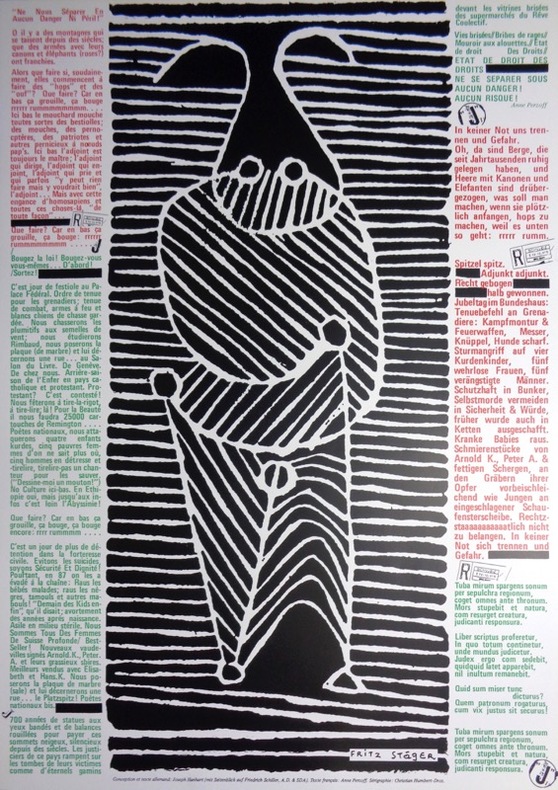
|
|
|
STÄMPFLI
Galerie Lelong in Paris 1988. Mit Widmung : Freundschaftlichst für Reto Casutt, (Signiert:) Stämpfli.
50x72.5 cm.
書籍販売業者の参照番号
: 1711.1aaf
|
|
|
Stéphane Marchetti
Affiches 1939-1945 . Images d'une certaine France
France Loisirs . 1982 . Préface d'Alain Weill . Jaquette illustrée
書籍販売業者の参照番号
: 1537
|
|
|
Stéphane Marchetti
Affiches. 1939-1945. Images d'une certaine France.
France Loisirs / Edita. 1982. In-4. Relié. 178 pages augmentées de nombreuses illustrations en noir et blanc et couleurs dans et hors texte. Texte sur deux colonnes. Avec Jaquette. Classification Dewey : 940.53-Seconde Guerre mondiale 1939-1945 Préface d'Alain Weill Classification Dewey : 940.53-Seconde Guerre mondiale 1939-1945
書籍販売業者の参照番号
: his11m ISBN : 272422972

|
|
|
Stéphane Marchetti
Images d'une certaine France Affiches 1939-1945 in-4,relié avec jaquette illustrée,178 pages
Edita 1982
書籍販売業者の参照番号
: EXP8840
|
|
|
Stéen, Denis
Holzschnitte und Holzstiche. Galerie Art+Vision, Bern. [Ausstellungsplakat / exhibition poster].
o.J. (Denis Stéen, geb. 1929 in Östhammar, Schweden, schwedischer Maler und Graphiker. 1952 bis 1956 Studium an der Valand-Ku
書籍販売業者の参照番号
: 66606CB
|
|
|
SUISSE. TOURISME. AFFICHE. BROOKSHAW (Percy Drake).
"Lausanne".
1955 Affiche titrée signée en bas à droite, Suisse, tirage Offset, (1955), 100 x 62 cm.
書籍販売業者の参照番号
: 24190
|
|
|
SUMMERS (Carol)
THE NEW YORK PUBLIC LIBRARY. 1974.
Affiche originale. ASTOR LENOX and TILDEN FONDATION. 1974. Impression en sérigraphie sur papier métallisé. En anglais, espagnol, hébreux, arabe et chinois. Dim: 610 x 777.
書籍販売業者の参照番号
: 3069

|
|
|
SUMMERS (Carol)
THE NEW YORK PUBLIC LIBRARY. 1974.
Affiche originale. ASTOR LENOX and TILDEN FONDATION. 1974. Impression en sérigraphie sur papier métallisé. En anglais, espagnol, hébreux, arabe et chinois. Dim: 610 x 777.
書籍販売業者の参照番号
: 3069

|
|
|
SUPERLEAGUE POOL VENDEE
"""Les 4 jours du Billard Anglais"". Les Herbiers - les 14 - 15 - 16 - 17 avril 2006"
***. 2006. In-12. Broché. Bon état, Couv. convenable, Dos satisfaisant, Intérieur frais. Affiche en couleurs de 40 / 60 cm.. . . . Classification : 300-Affiches Divers
書籍販売業者の参照番号
: RO80078838
|
|
|
SURBEK, Viktor:
Bern- Loetschberg -Simplon.
1959, 102 x 64 cm, Farbig-Offsetdruck - Affiche. illustrated poster (40,32 x 25,30 inch). (Encadrement sous verre).
書籍販売業者の参照番号
: 133332aaf
|
|
|
SURDIVES ET DESJARDIN. (Affiche).
Hôtel de la Pomme de Pin. Grande Rue St Jean N°24 tenu par Maubant, Rouen. Table d'hôte. Déjeuner à 10 heures - Dîner à 4h 3/4. Cet Hôtel, fréquenté de temps immémorial par les Commerçants, est également bien situé pour les promeneurs. Il est dans le centre de la ville, à proximité de tous les bureaux de Diligences, du Palais de Justice et des principaux monuments.
Rouen, 1842. Superbe affiche lithographiée, en couleurs (ivoire, rouge et bleu) par Nicétas Périaux (29cm x 24 cm), avec des motifs or en écoinçon. Parfait état dans un encadrement noir à liseré or (postérieur) en excellent état.
書籍販売業者の参照番号
: 20960
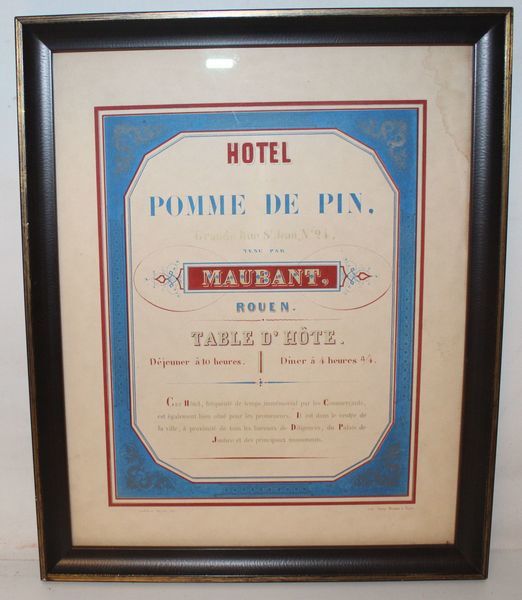
|
|
|
SURVAGE (Leopold Frédéric Léopoldovitch Stürzwage, dit Léopold).
Survage, Peintures 1916-1965. Au Pont des Arts, Galerie Lucie Weill, 6 rue Bonaparte - Paris VI. Du 4 au 28 mai 1965.
Affiche originale de l'exposition imprimée en lithographie par Mourlot (48/64 cm). Bon état.
書籍販売業者の参照番号
: awd-200

|
|
|
SUSKIN, Steven
A Must See ! Brilliant Broadway Artwork.
Chronicles Books, San Francisco 2004 In-4, broché, couv. illustrée rempliée, illustrtions en couleurs, 156 pp. En anglais. Très bon état d’occasion.
書籍販売業者の参照番号
: 20662 ISBN : 811842177
|
|
|
SUSAN ANSPACH - ERLAND JOSEPHSON - PER OSCARSSON
AFFICHE DE CINEMA - LES FANTASMES DE MADAME JORDAN - MONTENEGRO
DUSAN MAKAVEJEV. Non daté. In-12. Broché. Bon état, Couv. convenable, Dos satisfaisant, Intérieur frais. Affiche de cinéma 120 cm x160 cm. Présenté par Bo Jonsson.. . . . Classification : 0-Affiches Cinéma
書籍販売業者の参照番号
: R100000005

|
|
|
Suter Daniel:
Piscis helveticus, max. 700 ans.
Sérigraphie Humbert-Droz, 1991. Affiche sérigraphiée grand format, faisant partie d'une série réalisée par des dessinateurs du cru (toutes au format d'environ 70 x 100 cm.) célébrant à leur manière le 700e anniversaire de la Confédération suisse (1991, vous en souvient-il?).
書籍販売業者の参照番号
: 3198
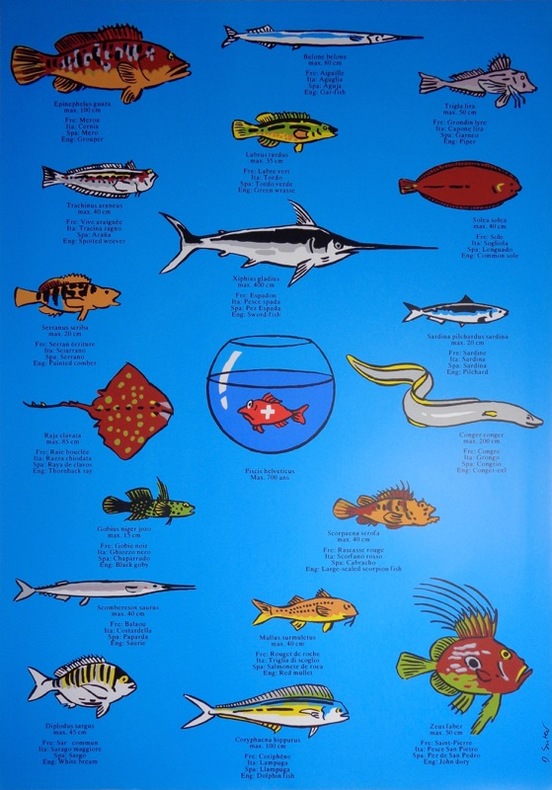
|
|
|
Svolinsky, Karel
Plakat / poster: Karel Svolinsky. Klingspor-Museum. Offenbach am Main. Ausstellung vom 7.XII. 1965 bis zum 15.III. 1966.
o.J. Karel Svolinský geboren 1896 in Heiligenberg bei Olmütz in Mähren; gestorben 1986 in Prag. Tschechischer Maler, Graphiker und Buchillustrator.
書籍販売業者の参照番号
: 44022BB

|
|
|
Swarte Joost:
10 angsten - 10 angoisses.
Brussel/Bruxelles Plaizier. Affiche au format 25 x 48, à l'état de neuf.
書籍販売業者の参照番号
: 3013
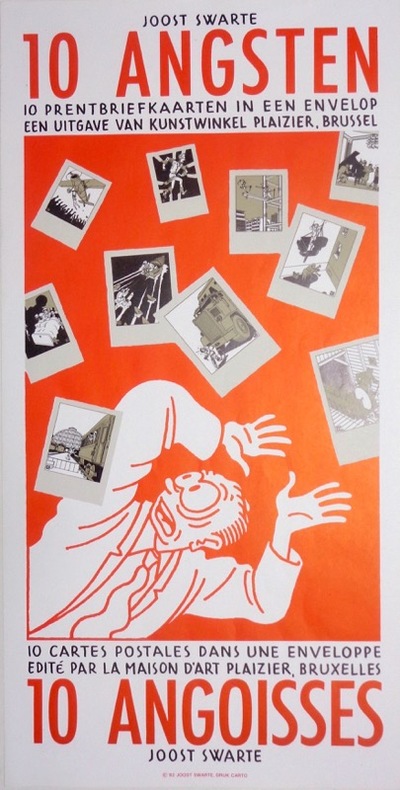
|
|
|
Swarte Joost:
Articulado - Un otono bienvenido.
Planche tirée de l'album Articulado (nous l'avons aussi !), au format 30 x 45 cm., en belle condition.
書籍販売業者の参照番号
: 3634
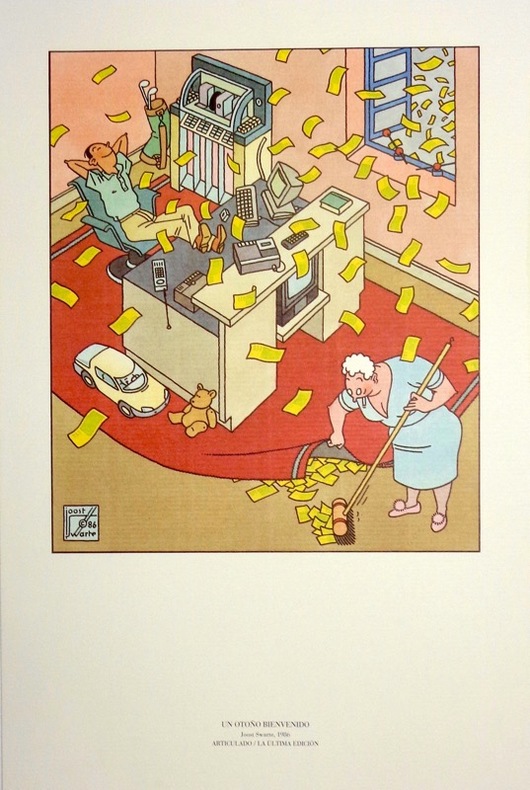
|
|
|
Swarte Joost:
Exposition Tentoonstelling.
Plaizier, 1982. Affiche au format 50 x 70 cm., à l'état de neuf.
書籍販売業者の参照番号
: 3051
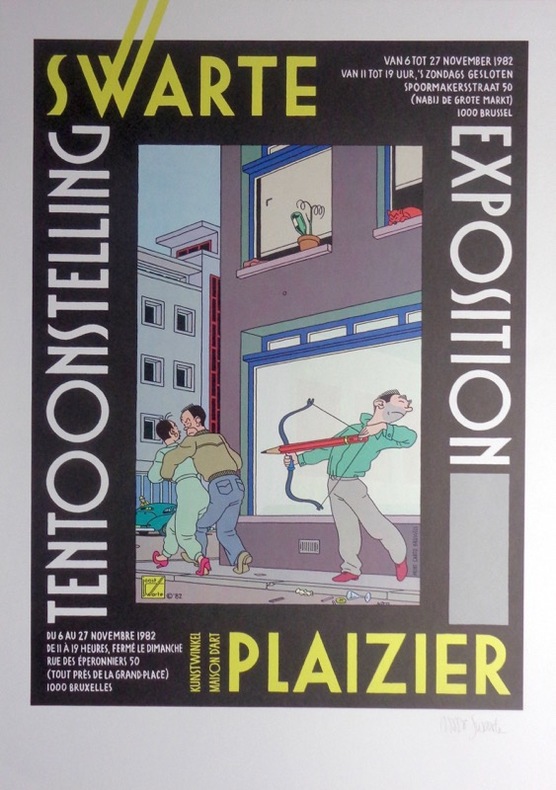
|
|
|
Swarte:
Joost Swarte in Galerie Lambiek.
Amsterdam, Lambiek, 1990. Affiche au format 68 x 30 cm, à l'état de neuf.
書籍販売業者の参照番号
: 2986
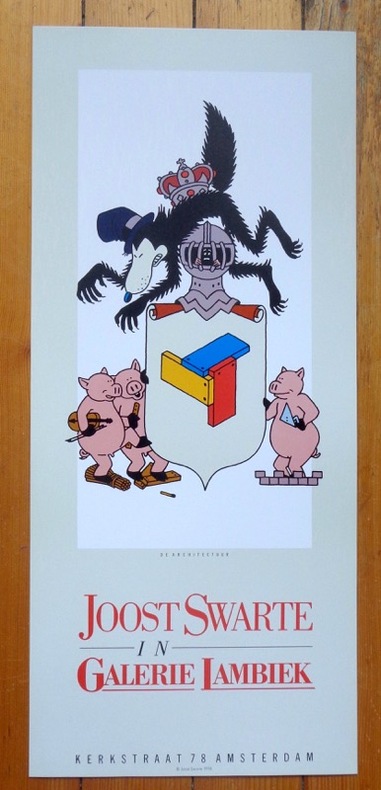
|
|
|
Swarte Joost:
Museo articulado.
Planche tirée de l'album Articulado (nous l'avons aussi !), au format 30 x 45 cm. Très léger pli au coin supérieur.
書籍販売業者の参照番号
: 6790
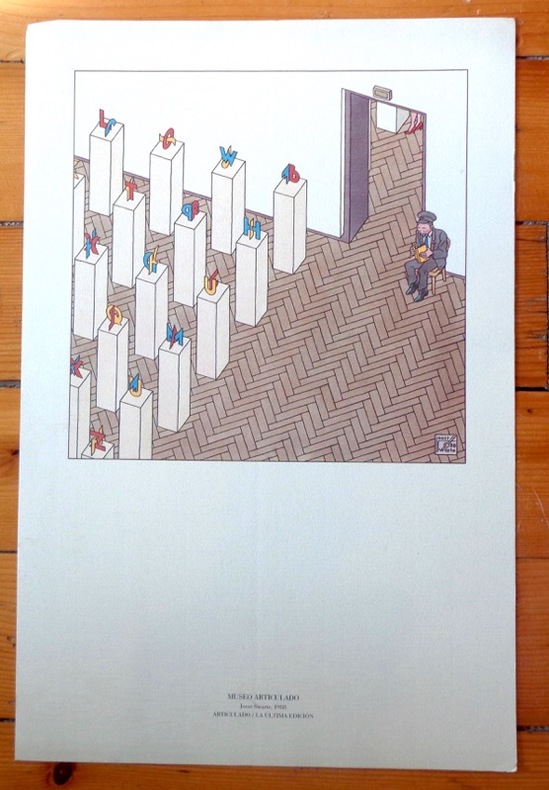
|
|
|
Swarte Joost:
Ochtendschemer.
Affiche au format 50 x 70 cm., à l'état de neuf.
書籍販売業者の参照番号
: 3054
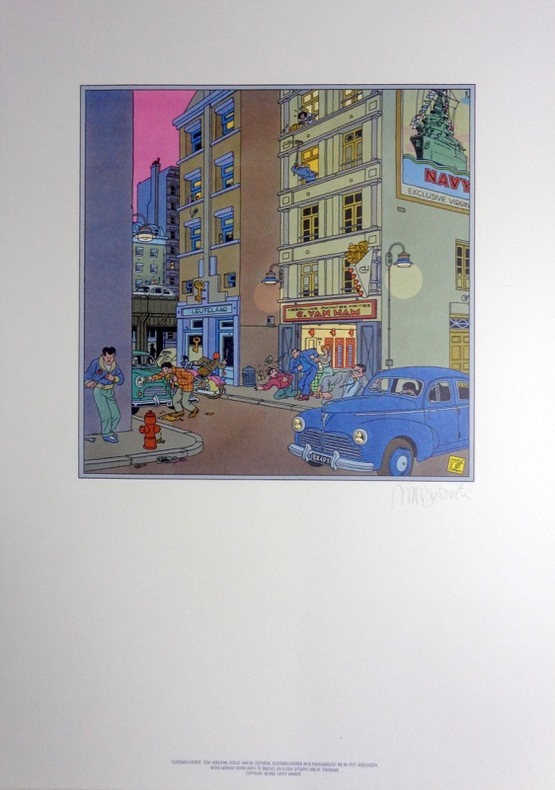
|
|
|
Swarte Joost:
Planche de vignettes.
Planche de vignettes détachables, au format 33 x 46 cm.
書籍販売業者の参照番号
: 3635
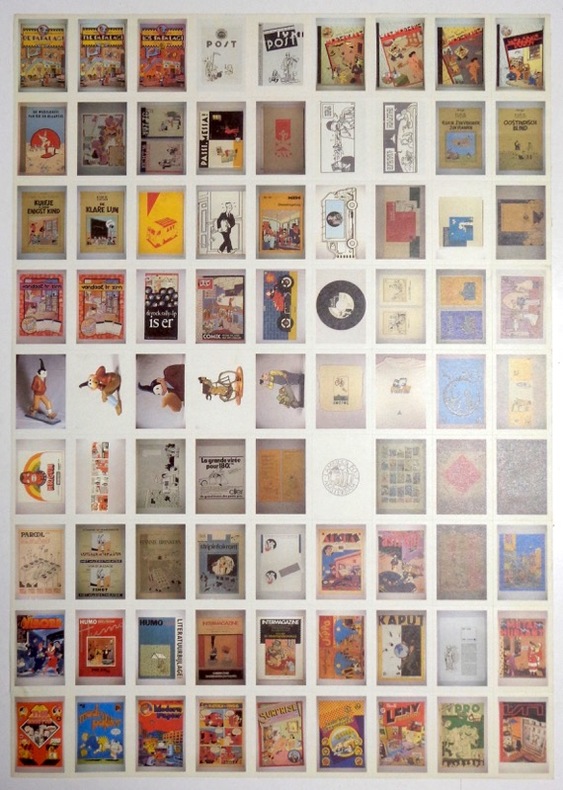
|
|
|
Swarte Joost:
Swarte y su arte. Sevilla.
PMJ. Affiche au format 40 x 60 cm, à l'état de neuf.
書籍販売業者の参照番号
: 2899
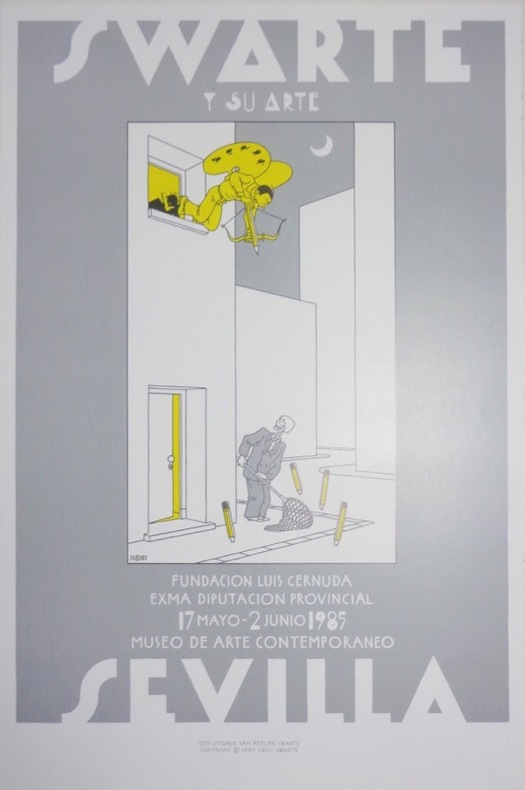
|
|
|
Swarte Joost:
Swarte, le livre, enfin.
Futuropolis. Affiche au format 33 x 59 cm., pli central, pour le reste en bon état.
書籍販売業者の参照番号
: 3009

|
|
|
Swarte
Tentoonstelling. Exposition. Swarte. Plaizier. Du 6 au 27 novembre 1982. Bruxelles. Signée.
Paris, 59/43 cm. Rousseurs en pied. Bon état.
書籍販売業者の参照番号
: 53282
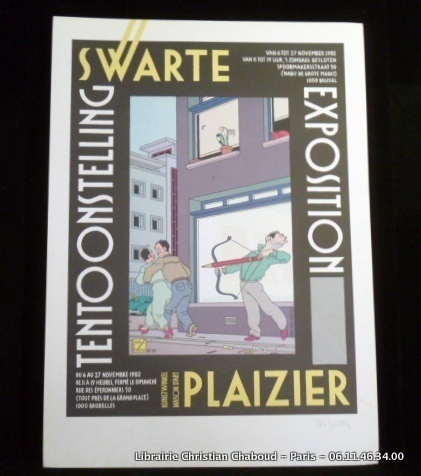
|
|
|
Swarte Joost:
Toneelschuur.
Affiche au format 60 x 80 cm., à l'état de neuf.
書籍販売業者の参照番号
: 3052
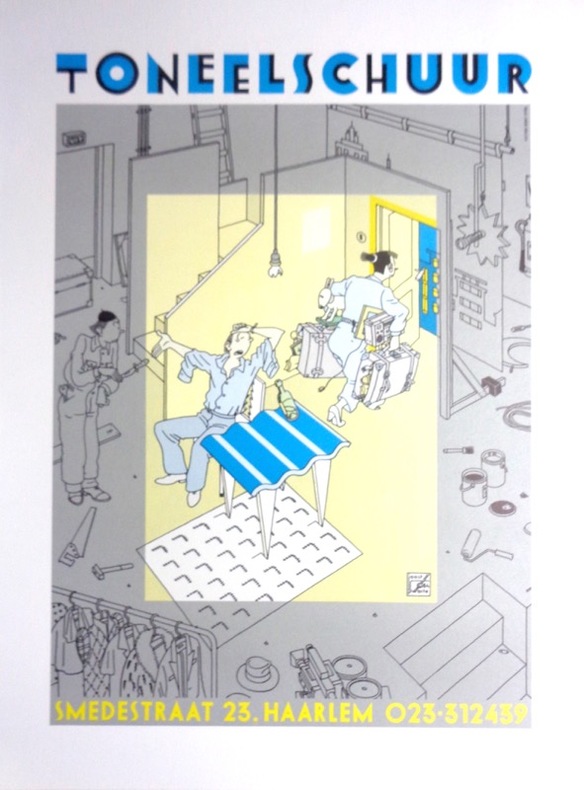
|
|
|
Swarte Joost:
Toneelschuur.
Haarlem, sans nom, [1996]. Portfolio au format 48 x 43 cm., fond en métal, charnière en rondin de bois, premier plat de carton ajouré. 12 pages de textes (en néerlandais) et 4 sérigraphies, chacune numérotée et signée par Swarte.
書籍販売業者の参照番号
: 9741
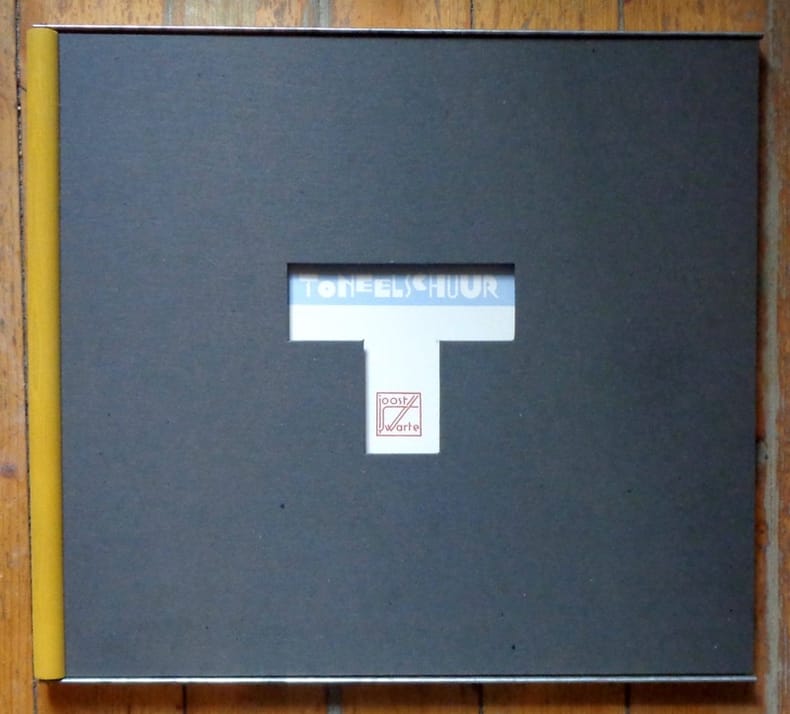
|
|
|